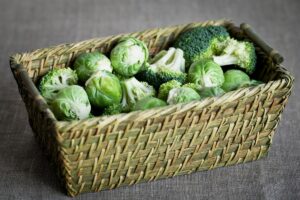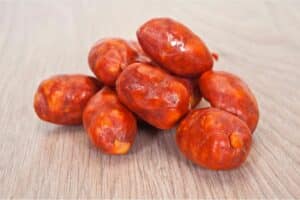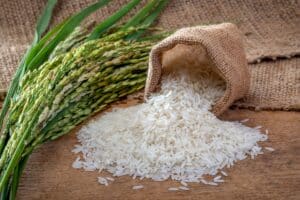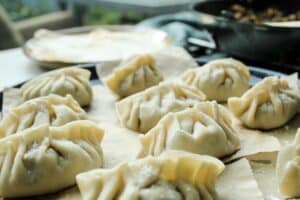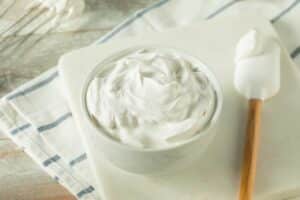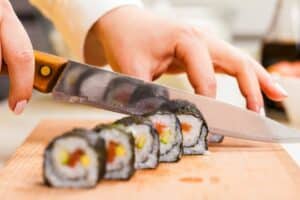Asian cuisine is delightful because many peoples and places have influenced the flavors, textures, methods, and ingredients. Whether it’s searching through recipes to cook at home or picking which option to order at a restaurant, we can often wonder about the differences in similar dishes.
Here we will compare Chow Fun and Mei Fun.
These are two common Asian rice noodles used in a variety of dishes and pair well with most vegetables and meats. While the results on the plate can seem similar, there are some notable differences between both of them.
So, what is the difference between chow fun and mei fun?
The main difference between chow fun and mei fun is the thickness of the noodles. While both are rice noodles made from rice grain and water, chow fun is a thick flat noodle, and mei fun is thin like vermicelli.
Chow Fun vs Mei Fun: How do they compare?
- Appearance: Chow fun is thick and flat. Mei fun is thin strings like angel hair pasta.
- Flavor: Both have a subtle, slightly sweet flavor. Noodles are not meant to take the lead in Asian dishes.
- Shelf Life: Both noodles keep for 2-3 years when sealed in their original packaging. After cooking, store in the refrigerator and eat your leftovers within five days.
- Use Cases: Chow fun is more commonly used in stir-fries, but you’ll find it in some soups also. Mei fun is used in stir-fries, soups, and cold noodle salads.
- Gluten-Free: Rice noodles are naturally gluten-free. However, the sauces you might put on these noodles often contain wheat products.
Comparison table
| Chow Fun | Mei Fun | |
| Appearance | Thick and flat | Thin, like angel hair pasta |
| Flavor | Subtle, slightly sweet | Subtle, slightly sweet |
| Use Cases | Stir-fries, soups | Stir-fries, soups, cold noodle salads |
| Shelf Life | 2-3 years before opening, refrigerate after cooking | 2-3 years before opening, refrigerate after cooking |
Can you substitute Chow Fun for Mei Fun?
You should not substitute one noodle for another because it fundamentally changes the dish. When you want to make chow fun, you need chow fun noodles. If you use mei fun, then you have made mei fun stir-fry.
When you search for recipes for Asian noodle dishes, you will find many common threads. Chow fun and mei fun recipes similar to one another are stir-fries.
Most noodle stir-fries include one or more kinds of protein, vegetables, and sauce. As you will read later in this article, there are several similar recipes for chow fun and mei fun. The noodles are a decisive difference.
It sounds a little confusing at first, but the name depends on the type of noodle that you are using. Let’s say you have chicken, sliced onions and green peppers, and soy sauce. You make two stir-fries with these ingredients. In one, you use chow fun and the other mei fun noodles.
You have actually made two dishes. You made chicken chow fun and chicken mei fun. Chow and mei fun differ in the size and shape of the noodles.
What is chow fun?
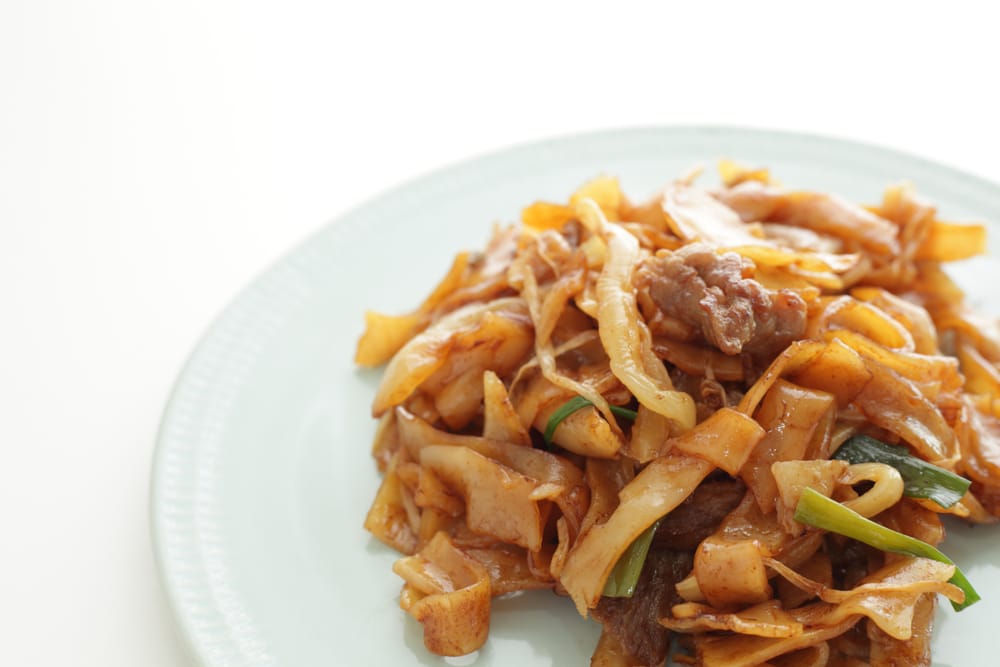
Chow fun, also known as hor fun, is a wide rice noodle. They are at least an inch wide, but you can find wider varieties. You can buy them in dried strips or sheets.
You will find it mainly in stir-fries and soups.
The Legend of Chow Fun
The true origin of Chow Fun is lost to history, but there is an intriguing story from WWII. The legend says that a man called Mr. Hui moved from Canton to Hunan to become a chef. Invasion by the Japanese forced him back home, where he worked at his family’s noodle stand.
One day, a hungry military commander demanded food from the family. They had run out of potato starch powder used to thicken the sauce. Mr. Hui decided to dry stir fry the noodles resulting in the dish that most of us recognize today as Chow Fun.
How to Use Chow Fun
There are nearly countless ways to prepare chow fun. These noodles go well with almost any combination of protein and vegetables. The most common dish is the Cantonese staple, Beef Chow Fun.
Beef Chow Fun includes marinated strips of beef, chow fun noodles, bean sprouts, onions, and soy sauce. In a wok, brown the beef first. Add in the noodles, onions, and soy sauce and keep stir-frying. Finally, add the bean sprouts and cook until they are tender.
Two Ways to Prepare Chow Fun
The two most common ways to stir-fry chow fun are wet frying and dry frying.
Wet Frying
You will include a thickening sauce in the stir-fry when you wet fry the chow fun. Mr. Hui could not wet fry the noodles for the military commander because he had run out of potato starch powder. Other common thickening agents are flour, cornstarch, and arrowroot.
Dry Frying
Dry frying can be a misleading name. The dish is not devoid of all moisture because all stir-fry includes oil, of course. A dry-fried chow fun does not have a thickening agent but includes only condiments such as soy sauce.
Dry frying is the more common method for chow fun today.
Whether you wet-fry or dry-fry your chow fun, you will want to blanch the dry noodles first. Bring some water to a boil and place the noodles in for about 30 seconds. Rice noodles are much more delicate than wheat-based pasta, so require much less cook time.
Key Factor for Great Chow Fun
The noodles are the second most important ingredient in delicious chow fun. The ticket to making the best chow fun at home is to cook in a wok.
Wok frying has a storied history in Asian cuisine. You can get close to the authentic flavors and texture in a frying pan, but the wok will take your cooking to the next level.
Heat the wok over a high flame and stir quickly as the food cooks, which is where we get the name stir-fry. Be sure not to stir too aggressively because you can break the noodles into pieces. Get the best results by learning to toss the stir-fry.
What is mei fun?
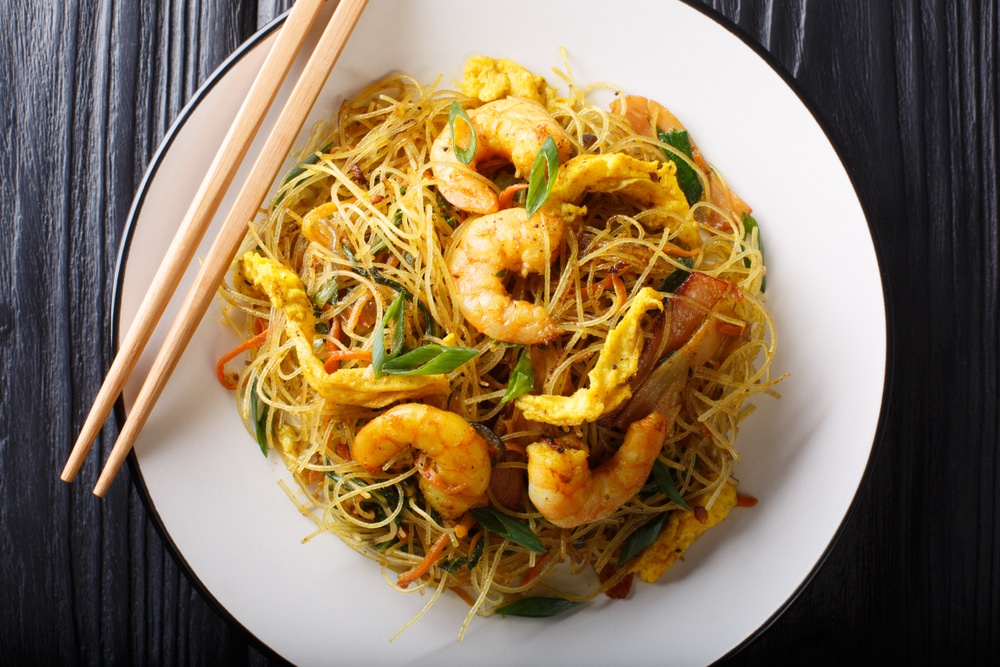
Mei fun is a thin rice noodle also known as rice vermicelli. Mei fun is often confused with cellophane noodles, which are made with mung bean starch or rice starch.
Mei fun is made with ground rice grains and water. These noodles have a mild taste with a hint of sweetness. Mei fun is available in pre-cooked and dried varieties. Briefly soak them in hot water to make them soft again.
How to Use Mei Fun
You’ll find Mei fun in cuisine from Japan, Singapore, Malaysia, Indonesia, Cambodia, Vietnam, and Thailand. The name for these noodles translates to “rice vermicelli” in each language.
A Cantonese dish that features mei fun is a simmered broth with fish balls, beef balls, or fish slices.
Stir Fry
A popular dish similar to chow fun is Singapore Mei Fun. Where it got that name is a mystery because it did not originate in Singapore. It is probably Cantonese, like Chow Fun.
However, Mei fun is a stir-fry dish made with noodles, multiple proteins, curry powder, and crunchy sliced vegetables. There are wet-fried and dry-fried versions of Singapore Mei Fun.
Pork and shrimp are the proteins you will typically find if you order Mei Fun in a restaurant. It’s common to include more than one meat in a single order. You will also find chicken or beef Mei Fun. At home, your pallet is the only limit.
You will want to cook these thin noodles in hot water but don’t boil. They are delicate and require that you handle them gently so you have intact noodles in your final dish.
Your wok is your best friend again for at home Mei Fun. You can use a sauté pan or skillet if you don’t own a wok. But you will get the best results with the right tools.
Salad
Mei fun outshines chow fun in its variety of uses. One way that mei fun breaks out of the stir-fry box is with cold noodle salads.
Many Asian noodle salads are meant to be served chilled and taste delicious.
Cold noodle salads give you a wide pallet of textures. You have soft, cool noodles accompanied by crunchy vegetables, chopped herbs, sprouts, and nuts. It’s all tossed with a zesty and refreshing dressing.
You don’t have to skip adding some protein to these cold salads. Chicken and shrimp both shine in a chilled dish.
Prepare the mei fun noodles according to the package. Usually, you will soak them briefly in a bowl of hot water. Eight ounces of noodles makes enough for four servings. The difference between making stir-fry and salad is the length of your noodles. Cut cooked noodles shorter for serving in a salad.
You might also find interesting: Sesame chicken vs general tso

